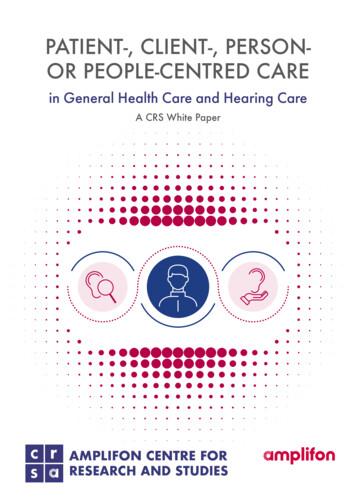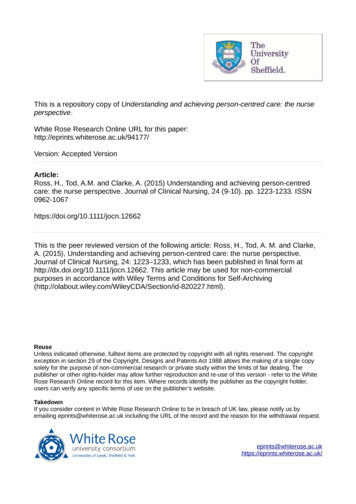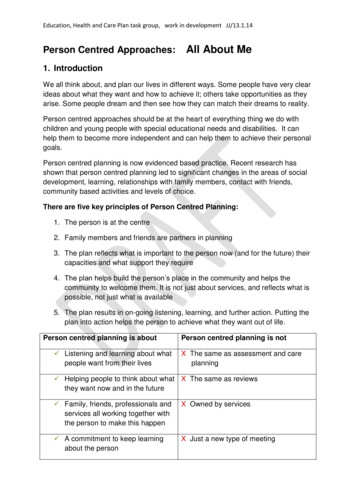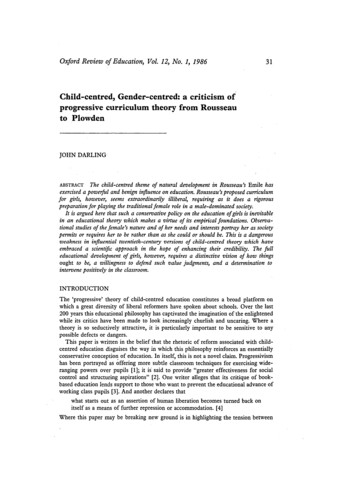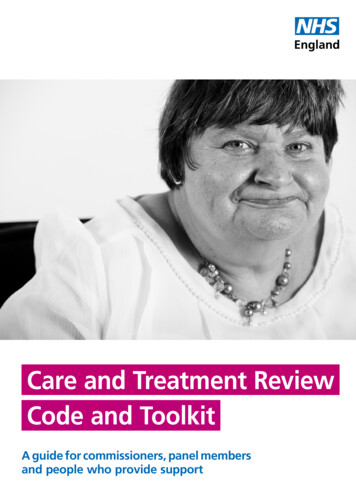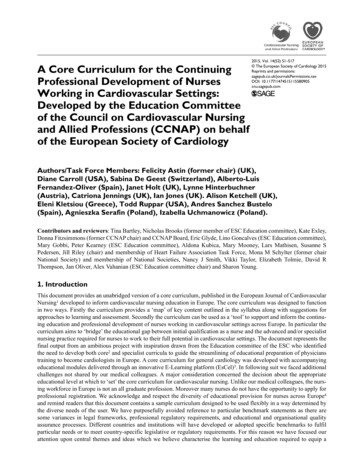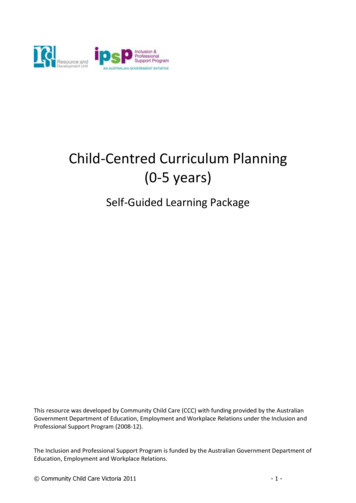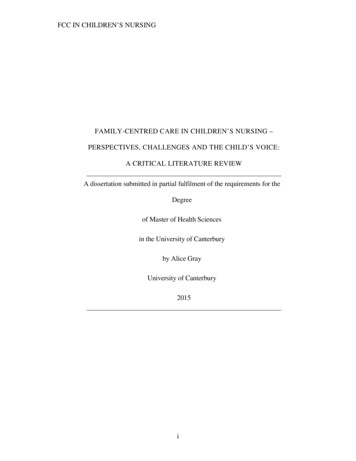
Transcription
FCC IN CHILDREN’S NURSINGFAMILY-CENTRED CARE IN CHILDREN’S NURSING –PERSPECTIVES, CHALLENGES AND THE CHILD’S VOICE:A CRITICAL LITERATURE REVIEWA dissertation submitted in partial fulfilment of the requirements for theDegreeof Master of Health Sciencesin the University of Canterburyby Alice GrayUniversity of Canterbury2015i
FCC IN CHILDREN’S NURSINGAbstractThis literature review investigates a possible theory-practice gap within Family-CentredCare in children’s nursing. The investigation into this theory-practice gap was conducted bycritically examining primary research that presents perspectives of those involved in FamilyCentred Care. Nursing, family and children perspectives were examined to reveal a number ofperceived challenges of Family-Centred Care in children’s nursing. However children’sperspectives revealed that children may not experience the same challenges, suggesting thatchildren’s views and the child’s voice may help to resolve the theory-practice gap. The rights ofthe child support the idea that the child’s voice is fundamental in children’s nursing, however itwas revealed that the child’s voice may not be acknowledged as it should. This may be due topoor understanding of the multidimensional ‘voice’. Role identification and decision-making areexamples of why the child’s voice should be fundamental in children’s nursing and this could beimproved with changes in nursing education. Children’s nursing may need to re-direct its focusfrom Family-Centred Care to a more child-centred model. Child-Centred Care is an area forfurther investigation to enhance the findings of this literature review.ii
FCC IN CHILDREN’S NURSINGFor my Mum, who I am unable to share this with. You inspire me every day, I hope I am makingyou proud.iii
FCC IN CHILDREN’S NURSINGAcknowledgementsThis dissertation would not have been possible without a number of supportive and inspiringpeople in my life. Firstly, I would like to thank Dad and Miriam for your constant support andmotivation, you both inspire me to make you proud, I am so excited to share this with you.Thank you to Toby, Luke, Amber and my friends for your encouragement through the years.Thank you Bradley for your optimism and humour, you motivated me through the hardest points.My gratitude also goes to my supervisor, Kirsten Gunn, whose passion and guidance has beeninvaluable in both writing and research. Lastly, I would like to thank and congratulate my fellowBN/MHealSci friends. We are almost there.iv
FCC IN CHILDREN’S NURSINGTable of ContentsAbstract . iiDedication. . iiiAcknowledgements . ivTable of Contents. vList of Tables . viChapter One. 1Personal Interest . 1Purpose of this Literature Review. 2Method . 2Search Results. 3Chapter Two . 5Background . 5Evolution of Children’s Health Care and the Development of FCC . 7Chapter Three. 15Nursing Perspectives . 15Family Perspectives . 26Chapter Four . 33Children’s Perspectives. 33Chapter Five . 39The Child’s Voice. 39Conclusion . 47References . 49v
FCC IN CHILDREN’S NURSINGList of TablesTable 1. Organisation of Primary Research10vi
FCC IN CHILDREN’S NURSINGChapter OneThis literature review will examine Family-Centred Care (FCC) in children’s nursing inorder to explore a possible theory-practice gap. A range of literature will be reviewed in order todiscuss the foundations of FCC in children’s nursing, its application, evolution and challenges ofimplementation in practice. This chapter begins with an explanation of how personal interestsdeveloped into a topic for this literature review. Following this, the purpose of the review will beoutlined along with details of the method used for searching the literature. The second chapterwill provide a background on FCC and explain how FCC has developed alongside children’snursing. This will include identification of important theoretical concepts of FCC andpartnership, and the existence of a theory-practice gap. The third chapter will present a criticalexamination of primary research that investigates nursing and family perspectives on FCC inchildren’s nursing and the fourth chapter will do the same for children’s perspectives. Thefindings of this examination will be considered in the fifth chapter, in which challenges that leadto the theory-practice gap will be addressed and possible ways forward for FCC discussed.Personal InterestMy interest in FCC grew from curiosity of children’s nursing. As a student, my experiencein this field of nursing currently reaches only as far as the literature. However, from this alone Idiscovered that the skill-base and knowledge involved in nursing a child and family is differentto that of adult nursing on many levels. I already had an interest in working in a negotiatedpartnership with patients, from my experiences in adult nursing and was interested in how thisrole may change, in the context of children’s nursing.1
FCC IN CHILDREN’S NURSINGI focused my initial literature search on the negotiated partnership with children, but withfurther research I identified that the inclusion of the family when caring for a child is a largefactor in this partnership. This refined my research further, until I was introduced to the conceptof Family-Centred Care. With only a glance at work on this concept, I established that it has highrelevance and importance in children’s nursing. I also established that the application of FCC inthis area carries with it some challenges, one in particular being a theory-practice gap and I wasimmediately drawn to the idea of investigating this. This topic also resonates with me on apersonal level as I have a family-member whose son is currently receiving hospital-level care.Talking with this family member assured me that the concept of FCC is a very relevant issue innursing; as the family member had both positive and negative things to say about it based onpersonal experience.Purpose of this Literature ReviewThis literature review aims to examine current published research on FCC andpartnership models of care in children’s nursing, in order to investigate a theory-practice gap.The findings will be discussed in order to determine possible solutions to challenges in theapplication of FCC to practice.MethodA literature search was performed in order to identify current published research on FCCin nursing. The search was performed on the following databases and search engines: CINAHL,MEDLINE and Google Scholar. The studies included in the critical examination of this revieware all within the 2005-2015 period, as these are the most recent and relevant. Search terms were2
FCC IN CHILDREN’S NURSINGused as key words as much as possible to ensure FCC was examined in a range of differentcontexts. Key search terms were: ‘family-centred/centered care’, ‘family-centred/centerednursing’, ‘participation’, ‘partnership’, ‘paediatric/pediatric nursing’, ‘child nursing’, ‘children’snursing’, ‘family’, ‘nurse perspectives’, ‘family/parent perspectives’, ‘child’s voice’,‘child/children perspectives’. Literature reviews were filed separately from primary research inpreparation for both a descriptive and critical review. Literature was excluded if it was notwritten in English, or did not include at least two of the following key words: ‘Family-centredcare’; ‘partnership’; ‘participation’; and ‘perspectives’. In addition to this, primary research wasexcluded if it did not state a purpose to examine perspectives of nurses, families or children. Anadditional search was conducted using the key words ‘child’s voice’, ‘children’s nursing’ and‘child-centred care’.Search ResultsSeven pieces of primary research were selected for critical examination and all werepublished between 2007 and 2015. Of these, three studies were utilised to examine nursingperspectives only, one was utilised to examine family perspectives only, one was utilised toexamine children’s perspectives only, one was utilised to examine nursing and familyperspectives and one was utilised to examine all three perspectives (Table 1).3
FCC IN CHILDREN’S NURSINGTable 1Literature Included in ReviewPerspectivesPrimary ResearchNursingLee (2007)Hughes (2007)Coyne (2008a)Coyne et al. (2011)Coyne (2015)Hughes (2007)McDowell et al. (2015)Coyne (2015)Pritchard Kennedy (2012)Coyne (2015)FamilyChildren4
FCC IN CHILDREN’S NURSINGChapter TwoBackgroundThis chapter will explain the concept of Family-Centred Care (FCC) in children’s nursingand provide an explanation of its history and evolution. FCC is a philosophy of care used inchildren’s nursing and utilised in many health care settings around the world (Harrison, 2010).To understand the concept of FCC, it is necessary to explore how it is defined in the literature.Shields, Pratt and Hunter (2006, p.1318) suggest that FCC is “a way of caring forchildren and their families within the health services, which ensures that care is planned aroundthe whole family, not just the individual child or person, and in which all family members arerecognised as care recipients”. Evans (1994, p. 477) suggests that the concept of FCC is bestdefined as “care-by-parents”; an interesting suggestion, as it can be argued that family is notdefined as just “parents”. Casey (1988) (cited in Lee, 1998, p. 205) suggests that family meansnot only parents, but any others who significantly influence the continuing care of the child’.Stower’s (1992, p. 68) definition of FCC refers to FCC in a specific environment; “partnershipcaring; focusing the child’s care around the child and their family and including as much normalhomelike activity as is possible in the hospital”. Smith, Coleman and Bradshaw (2009, p. 27)perhaps encompass all of these concepts and propose a definition, which could be argued as aleading one for FCC research and implementation; “The professional support of the child andfamily through a process of involvement, participation and partnership underpinned byempowerment and negotiation”. Although a wide range of definitions exist, academics andhealth professionals acknowledge that FCC is governed by a number of principles or key5
FCC IN CHILDREN’S NURSINGelements; these principles are visible in FCC practice today (Smith, Coleman & Bradshaw,2009).A popular list of key principles was generated by Shelton and Stepanek (1994) which,when summarised includes; acknowledgement of the family as a constant in the child’s life;facilitating of family-professional collaboration at all levels of hospital, home and communitycare; exchange of complete and unbiased information between families and professionals;honoring of cultural diversity; recognising and respecting different ways of coping; encouragingfamily-to-family support networking; ensuring support systems are accessible, flexible andcomprehensive; and appreciating families as families and children as children. These elementsare built on a foundation of communication, which holds them all together, and crafted with theintention that each succeeding element strengthens the one before it (Shelton & Stepanek, 1994).Other sets of principles exist in the literature. More recently, Kuo et al. (2012)summarised a list of general FCC principles; information sharing, respect and honouringdifferences, partnership and collaboration, negotiation and care in context of family andcommunity. There are similarities between these principles and those of Shelton and Stepanek.For instance, the category of respect and honoring differences includes cultural diversity anddifferences in coping, both of which are included in Shelton and Stepanek’s key elements ofFCC (Kuo et al., 2012, Shelton and Stepanek, 1994). Another similarity is the acknowledgmentof flexibility of support services, procedures and practices (Kuo et al., 2012, Shelton andStepanek, 1994).However, the principles of Shelton and Stepanek (1994) have been critiqued for onlyfocusing on the attributes of FCC and not giving insight into implementation of FCC in practice(Hutchfield, 1999). Kuo et al. (2012) could be critiqued for the same reason, as well as not6
FCC IN CHILDREN’S NURSINGacknowledging the evolution of FCC. Smith, Coleman and Bradshaw (2009) suggest that theexistence of various principles signifies both holistic and functional views of FCC. WhileShelton and Stepanek (1994) and Kuo et al. (2012) may represent the holistic view, Nethercott(as cited in Hutchfield, 1999) denotes a more functional one. Nethercott (Hutchfield, (1999)presents a list of components of FCC that acknowledge the use of FCC in practice. This list ofprinciples focuses on supporting family members’ participation and partnership, and is clearlymore appropriate for the practical setting. These principles include, the family must be viewed inits context; the roles of individual family members must be evaluated; families should beinvolved in the technical aspects of care; usual child care practices promoted in hospital, unlessdetrimental to the child; the support given to families should continue after discharge(Hutchfield, 1999, p.1180). Although Nethercott’s (Hutchfield, 1999) list of principles appears tobe more representative of how FCC should be practiced, it may be too task-focused andexclusive of wider aspects. It is possible that a list constructed from both the holistic andfunctional principles could be a more ideal balance of attributes and application.Evolution of Children’s Health Care and the Development of FCCThe United Kingdom is the source of much of the recent and relevant literature on FCCin child health; this is also true for historical literature. FCC has been evolving and developing inchildren’s health care since the 1950’s and Shields (2010) suggests that until this time, theconcept of Family-Centered Care and the principles it represents were unheeded amongst healthprofessionals, including nurses. Before this time, children were admitted to hospital and parentswere allowed to visit for, at best, half an hour per week (Jolley & Shields, 2009). Carter, Bray,Dickinson, Edwards and Ford (2014) suggests that this was because the strong, emotional7
FCC IN CHILDREN’S NURSINGresponse of children to these visits was viewed as harmful and infection control was of highpriority. However, Jolley and Shields (2009) propose that it was due to ignorance of clinicians tothe developmental, social and psychological needs of children, which was rife during this time;children viewed hospital staff as “non-human” and nurses as “uncaring” (Jolley & Shields, 2009,p. 165). Bruce and Ritchie (1997) propose that recognition of the pivotal role of family in thechild’s life was critical in the evolution in children’s health care and the development of FCC.Bowlby, Robertson and the Platt Report. The mid-twentieth century saw a period ofsocial change and a turning point in attitudes towards care of children in hospital in the UK.Jolley and Shields (2009) suggest that a catalyst for this change was World War II, as it broughtwith it much suffering and grief from separation, resulting in increased concern for thepsychology of both adults and children. Work by child psychologist John Bowlby, social workerJames Robertson and the release of the Platt Report in 1959 in Britain, steered research on thepsychological effects of parental separation for the ill child. Bowlby published about separationanxiety, grief and the attachment theory (Alsop-Shields & Mohay, 2001). Although he wascriticised for making broad assumptions with limited data, Bowlby crafted new thinking andgenerated much research regarding the potential damage separation can cause a child (AlsopShields & Mohay, 2001). Robertson formed a theory of phases of child responses to a stay inhospital without the mother; these phases were protest, despair and denial/detachment (AlsopShields & Mohay, 2001). Robertson also presented both his and Bowlby’s research to a range ofhealth professions in the form of films (Alsop-Shields & Mohay, 2001). Although Bowlby andRobertson were not nurses, their work is believed to have reached a wide range of nursing circles8
FCC IN CHILDREN’S NURSINGat the time and informed a number of changes in children’s nursing (Alsop-Shields & Mohay,2001).Bowlby’s work was utilised and disseminated all around the world by James Robertson,who made seminal films of the effects of parental separation during hospital admission (Jolley &Shields, 2009). However, Bowlby and Robertson’s research directions eventually began to moveaway from each other; as Bowlby continued as a theoretician. Robertson, with help from hiswife, continued to make films that had a significant impact on health professionals (AlsopShields & Mohay, 2001). Despite their parting of ways, Bowlby and Robertson etched thebeginnings of FCC into child health and they influenced significant publications in health care.One of these publications was The Ministry of Health Report, The Welfare of Children inHospital, better known as The Platt Report (1959), it offers a list of recommendations for a morehumanitarian approach to children’s nursing (Carter et al., 2014; Darbyshire, 1993). The reportwas a catalyst for a union of opinions in the British health system, as well as other countries(Davies, 2010). It represented important changes in society and hospital care systems and alteredthe attitudes of health professions towards the parents of sick children (Davies, 2010). However,The Platt Report was slow to be implemented in all areas of child health (Darbyshire, 1993) andit could be argued that its recommendations have not yet been fully addressed today (Davies,2010). Despite this, many of the report’s recommendations have been implemented and providethe foundations of the evidence bases of many child health nurses (Davies, 2010). The PlattReport and the work of Bowlby and Robertson were evidently fundamental to the developmentof child health and therefore facilitated the growth of FCC in children’s nursing; in fact theirwork has influenced many of the models of FCC seen today (Aslop-Shields & Mohay, 2001).9
FCC IN CHILDREN’S NURSINGAdvocacy Groups. The work of Bowlby and Robertson and their influence on the PlattReport are major foundations of many groups advocating for child health services; many of thesegroups supported the development of FCC and became important FCC advocacy groups (AlsopShields & Mohay, 2001). In 1961, a group called Mother Care of Children in Hospital wasfounded in Britain to ensure the enactment of the recommendations of the Platt Report (Jolley &Shields, 2009); this became the National Association for the Welfare of Children in Hospital(NAWCH), which is now Action for Sick Children (Alsop-Shields & Mohay, 2001).This group was the catalyst for other advocacy groups. In the USA, The Association forthe Care of Children in Hospital (ACCH) was created and the Association for the Welfare ofChildren in Hospital (AWCH) formed in Australia in 1973 (Alsop-Shields & Mohay, 2001).Alsop-Shields and Mohay (2001) suggest that later work from Robertson and his wifeencouraged these advocacy groups to form to ensure maintenance of good paediatric practices.This was the inspiration for the establishment of the Institute of Patient- and Family-CentredCare (IPFCC) in America in 1992, which became heavily involved in advancing understandingand practice of FCC; the IPFCC continues to have a major influence on FCC policy anddevelopment in the US and prioritises many of the FCC principles proposed in the literature(Institution for Patient- and Family-Centred Care [IPFCC] 2010). Although these groupsadvocate for FCC practice, they are confined to single countries and are not necessarily specificto nursing.Casey’s Framework. One of the models of FCC, influenced by the work of Bowlby andRobertson, is Partnership-in-care; this was developed by New Zealand nurse Anne Casey, whowas working in the UK at the time (Jolley & Shields, 2009). The model started to emerge in the10
FCC IN CHILDREN’S NURSINGearly 1990’s and involved two main principles; nursing care for a child in hospital can be givenby the child or parents, with support and education from the nurse; and family or parental carecan be given by the nurse if the family is absent or unable or unwilling to provide the care theynormally provide (Jolley & Sheilds, 2009, p.168).Casey (cited in Lee, 1998) emphasised the importance of viewing the family as a whole,and encouraged active participation in both normal family or parental cares and nursing cares.Lee (1998) suggests that Casey’s main aim was to create equilibrium between the child, familyand nurses, using partnership as a focus. Casey provides a definition for family, “usuallyconsidered as a group which carries out certain social and biological functions taken to meanparents and others who significantly influence the continuing care of the child” (Lee, 1998,p.205). Farrell (1992) explains that Casey’s model involves five concepts: the child, health,environment, family and the nurse and is a flexible way to design care to suit the needs of a sickchild. The model takes into account the importance of roles and responsibilities and encouragesactive participation and partnership between different roles (Farrell, 1992).It would be fair to argue that Casey’s Partnership-in-Care model is a fundamentallyrelevant to FCC and studies investigating partnership in practice will be explored in the nextchapter. However, as the next chapter will identify, application of the model to practice is not asimple feat. It is important to identify the challenges presented in the application of FCC topractice in the child health setting.Darbyshire’s Research. Darbyshire’s (1993) research, about parents and nurses inpaediatric nursing, was key in that it led to acknowledgment of the challenges associated withFCC implementation in children’s nursing. Darbyshire (1995) points out that there is a danger of11
FCC IN CHILDREN’S NURSINGprevailing a positive and uncritical view of FCC because it has evolved to improve children’shealth care from what it once was. However, the application of FCC is not unproblematic andDarbyshire (1993) suggests that the implementation of FCC is not as the literature wouldsuggest. Some problems that Darbyshire (1995) identified included; nurses’ views of “families”are not the reality, but socialised ideals; nurses struggle with determining the roles of differentfamily members; the needs of the parent, in specific circumstances, were not being identified;and parents having to exist in a different environment, now performing everyday tasks in“public”. Darbyshire (1995) concluded that children exist in a “web of relationships” and,despite the positive attributes of FCC, its application to practice is not as simple as someliterature may suggest.FCC Today. Coyne et al. (2011) states that, more recently, the concept of FCC ispracticed through a range of different theories and perspectives; from parent participation in care,to partnership-in-care, to care by the family as a whole. Despite this range of views, Jolley andShields (2009) suggest that the theoretical foundations of FCC are widely and commonlyacknowledged around the world. Many relevant theories are demonstrated in practice andBowlby and Robertson’s work continues to form the theoretical base of FCC understanding(Alsop-Shields & Mohay, 2001). Most child health professionals believe that FCC has becomethe best way to deliver care to children in hospitals (Jolley & Shields, 2009). According toCarter, Bray, Dickinson and Edwards (2014), FCC is the most common theoretical methodreinforcing child nursing in Western countries, including New Zealand, the United States,Canada and the United Kingdom.12
FCC IN CHILDREN’S NURSINGHowever, despite the apparent popularity of FCC, it is clear from the existing literaturethat its implementation in practice appears to present challenges for nurses (Coyne et al, 2011;Shields, 2010; Shields, 2005; Franck & Callery, 2004; Shields, Pratt & Hunter, 2005; Bruce &Ritchie, 1997). This results in inconsistent application of FCC in the clinical setting, which issupported by a dearth of evidence relating FCC to improved child health outcomes (Foster,Whitehead & Maybee, 2010). Ultimately, Shields (2010) suggests that the FCC model is merelyan ideal, given lip service in documents and policies, but lacking in evidence; this echoes earliercriticism by Darbyshire (1995).Franck and Callery (2004) identified the “theory-practice gap”, arguing that althoughthere is a vast collection of reliable literature on FCC, it is not translated into consistent andeffective practice in the clinical setting. In addition, there is a distinct absence of reliableevidence of the use of FCC in children’s nursing. This argument is supported in literature byacademics, including nurses, who argue that the reasons for this “theory-practice gap” should beexamined (Foster et al, 2010; Franck & Callery, 2004; Coyne et al, 2011; Bruce & Ritchie, 1997;Kuo et al, 2012; Shields et al., 2006). One way to do this, is to critically examine literature thatassesses the perspectives of those involved in FCC in children’s nursing13
FCC IN CHILDREN’S NURSING14
FCC IN CHILDREN’S NURSINGChapter ThreeThis chapter will focus on the perspectives of nurses and families on FCC in children’snursing. A large amount of literature refers to these different perspectives in an attempt toexplore the use of FCC in children’s nursing. With this in mind, examining the nursingperspective of FCC in children’s nursing, and the theory it is built on, is an obvious place to startwhen probing the theory-practice gap. As described in the previous chapter, both Casey (cited inLee, 1998) and Darbyshire (1995) discussed partnership and participation as fundamental aspectsof children’s nursing nursing and Lee (2007) argues these aspects are part of the FCC spectrum.This spectrum is described by Smith and Coleman (2009) as a practice continuum that can bepracticed at different levels, depending on parent needs and nurses’ abilities to facilitatepartnership. Shields, Pratt and Hunter (2006) suggest that partnership between family and healthprofessionals is a primary principle of FCC. Considering this, studies examining perspectives ofpartnership and participation by nurses and families will be included in this chapter.Nursing PerspectivesLee (2007). Partnership with families in children’s nursing is explored by Lee (2007),who studied a small sample of nurses (n 10) in an inner city trust in the UK. The study wasconducted using semi-structured interviews and Lee (2007) justifies the use of these byexplaining the benefit of interviewing based on topics or schedules, as opposed to pre-defined,scripted questions. This is supported by Barriball and While (1994, p.330) who state that semistructured interviews are ‘well suited
community. There are similarities between these principles and those of Shelton and Stepanek. For instance, the category of respect and honoring differences includes cultural diversity and differences in coping, both of which are included in Shelton and Stepanek's key elements of FCC (Kuo et al., 2012, Shelton and Stepanek, 1994).
